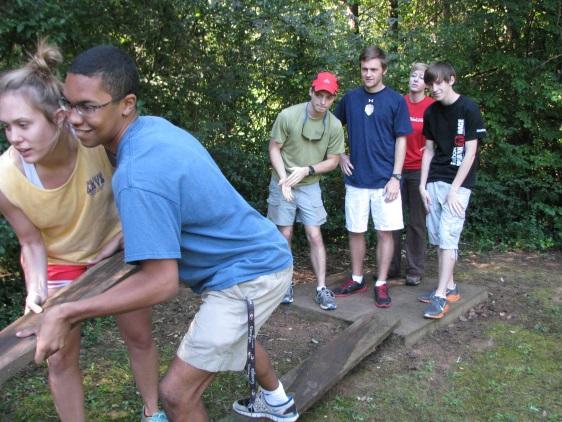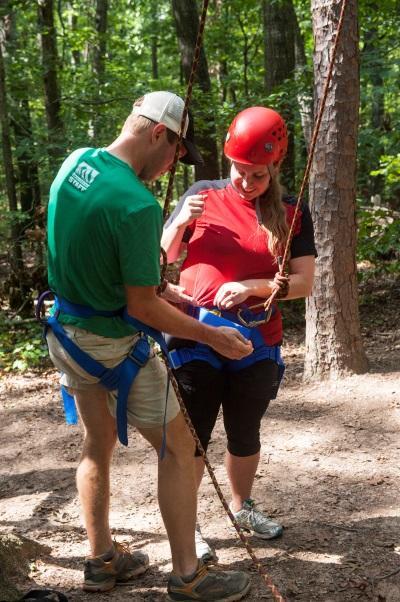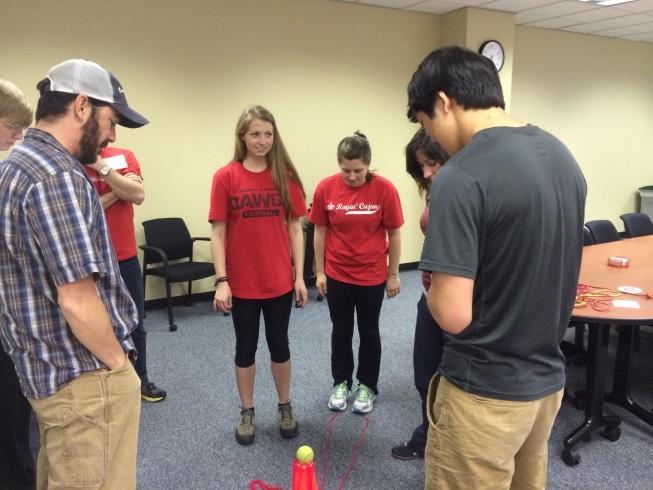Main Body
4. Facilitation Basics
What are the necessary steps to take when creating a team-building program?
Program Planning Outline
- Step 1 – Assess Group Demographics
- Step 2 – Facilitator Planning and Preparation
- Step 3 – Pre-Activity Checks
- Step 4 – Orientation
- Step 5 – Challenge Course Sequence (Re-adjust plan according to the dynamics of the group and continually process the experience)
- Step 6 – Debrief
- Step 7 – Follow-Up
Which factors play an important role?
1. Program Planning and Sequencing
All teambuilding programs should be designed to meet the needs and objectives of the group. Therefore, an assessment should be done in advance so that the facilitator knows what to expect in regard to the needs and qualities of the group. As a facilitator, choosing the activities that you feel will best meet the group’s goals is an important first step in developing a teambuilding program.
2. Program Length
The program length and available time will vary depending on your group.
3. Group Size
One facilitator per 12 participants is the ideal group size (occasionally one facilitator per 15 participants).
4. Setting the Stage
- Talk about the group members’ expectations for the program. What do they want?
- Help participants generate goals and expectations for the program.
- Challenge by Choice
- Set the mood and tone: upbeat, confident, compassionate
5. Choosing Activities
After gaining an understanding of the group you will be working with, begin to plan the program. Keep the following general information in mind as you select activities:
- Ages 8-12: you may want to choose activities that require physical activity to keep them interested. Experiential debriefs will work best.
- Ages 12-16: you may need to plan more activities for this age, as they will spend less time on debriefing than older students and adults.
- College-aged and older: Alternate physical and cognitive challenges.
- Adults: They like to spend time processing each activity. Therefore, don’t be surprised if you don’t get through all the activities that you had planned.
6. Sequencing Activities
After you have chosen the activities that you feel will help the group meet its goals and objectives, arrange them in a sequence that will be comfortable for the group.
7. Adjusting the Plan
Deciding whether to make adjustments to the activities you planned is a skill that takes practice. As a facilitator, watch how the group works together and be prepared to substitute activities that will help them to better meet their objectives. The following are some general questions that may be helpful as you make your decision to re-adjust:
- Are there any resistant members?
- Are they comfortable with physical contact needed for some activities?
- Are they being sufficiently challenged?
- Do they plan and listen to one another?
- Do you have a participant that is injured or unable to participate in your original plan of activities?
- How’s the weather? You may need to adjust your plan from outside to inside.
For example, if one or two members are resistant, you may not want to begin with activities that require a high degree of support and trust. If the participants are not comfortable with physical contact, you may need to move gradually into activities that require them to physically support others. If they seem to be disinterested, increase the challenge of an activity to spark their enthusiasm. If you find that they are not planning or listening, you might try some introductory communication exercises.
What are different types of activities when preparing a team-building program?
Elements refer to structures that have been built on a low or high ropes course that help develop teamwork and enhance group dynamics. Elements provide an experience for a group to learn and grow as a team. Debriefing the experience at the end of each element is important.
Group Initiatives are team-building activities that are not secured in one place but can instead be created in different environments using various resources (e.g., hula-hoops, rope, poly-circles, etc.). Like elements, initiatives also provide an experience for a group to learn and grow as a team, and debriefing should occur at the end of each initiative.
Icebreakers are activities used to “break the ice” in a group. They get a group interacting with one another and often include games that focus on getting to know names. Icebreakers do not need to be debriefed.
Energizers are designed to get a group energized and excited. Energizers can be used when a group’s energy level is waning mid-way through an experience, or at the beginning of an experience to get the group excited about what they are about to participate in. Energizers do not need to be debriefed.
Time-Fillers are used to keep a group engaged if there is a moment of down-time.
Often, several groups are out on a challenge course at the same time, and facilitators may be sharing different initiatives and elements. If a group has to wait a few minutes for a group to finish an element, a time-filler can be used to keep the group engaged in their experience. These activities usually have an element of team-building to them and are more involved than an icebreaker or energizer, but not quite as involved as a group initiative. A facilitator may choose to debrief a time-filler, depending on the activity selected, but debriefing is not always necessary.


How do you pick the right activity?
Picking the flow of activities for a group’s experience is important to accomplish the group’s objectives. It is important to have a conversation with the group’s leader to gain the insight to plan appropriately. The group’s leader can also help a facilitator gain an awareness of who the group is and gauge what their comfort level may be with ropes course experiences. In starting out a challenge course experience, it is important to begin by learning individuals’ names; even if the group members know each other well, it will help you to know their names when you start debriefing different experiences. An experience should increase in difficulty, so beginning with icebreakers or energizers will help participants become more comfortable in their environment. Once a solid foundation amongst the participants is built, you can move into more challenging initiatives and elements.
What does it mean to be a facilitator?
The Merriam-Webster dictionary defines “facilitate” as the ability “to make easier” or to “help bring about.” Challenge course facilitators “make easier” and “help bring about” a group’s team-building experience by providing rules and safety guidelines related to different initiatives. Challenge courses can create powerful experiences that can bring a group together or divide them even more. In addition to ensuring the physical safety and mental well-being of participants, facilitators should also help a group meet its goals and objectives for the experience.

What are the key things to remember in facilitating an activity for a group?
Participant to Provider
This experience is about your participants, not you. This is your chance to create a positive experience for participants, not to be a part of the group.
Framework for the Experience
Provide a good framework to begin the experience by introducing yourself and what participants can expect during the day. Always talk about Challenge by Choice, Safety and the Full Value Contract (see Team-building modules).
Listening
Listen twice as much as you talk, and pay attention to what the group’s goals are to ensure that their needs are met.
Verbal & Non-Verbal Cues
As a facilitator, you will be scrutinized by your participants, and they will read your verbal and non-verbal cues. If your voice reflects frustration, they will notice and adjust their behavior, even if that does not adequately reflect their experience. If you are watching a group on an initiative and make a face that shows your concern or disdain for their actions, they will know to stop trying.
Eye-Contact
It is important for participants to see your eyes when you are delivering instructions or debriefing. Eye contact lets a participant know that you hear what they are saying, and it lets you make eye contact to ensure that the group is paying attention to instructions or discussion. Sunglasses, hats, and other eye contact barriers should be avoided.
Circles
A circle allows a facilitator to make eye contact with every participant and ensures that everyone can hear instructions that are being delivered. Circles are also helpful in debriefing conversations.
Silence (the art of the pause)
Facilitators often ask a question only to be met with silence from the group. Rather than sit in that silence, they will often offer their own response or ask another question, and thus miss a wonderful discussion opportunity. When asking questions during the debriefing session, pause before asking the next question. Usually counting to 7 or 10 provides enough time for someone to respond. If participants don’t respond after that time frame, rephrase your question or ask another one.
What Makes a Good Facilitator?
- Passion
- Attention to Detail
- Listening to needs and goals
- Planning to meet needs
- Sequencing activities to build familiarity/trust
- Providing good framework to begin the experience
- Introduce yourself and the day
- Provide logistical info for the day
- Always talk about Challenge By Choice, Full Value and Safety
- Knowing the rules of the program, facility and games
- Observation of group in process (includes listening) – Don’t laugh at them!
- Making good judgments
- When and how far to push someone
- When to stop or change plan
- Taking action
- Making SAFETY concerns a priority at all times!
- Adaptability
- With the plan for the day
- With the rules/parameters of the games
- Creativity
- Making up new games or rules
- Finding new ways to engage participants in discussion to hear from everyone
- Asking open ended questions when facilitating discussion
- Creating Learning Moments that lead to some sort of change
- In the course of the day
- Inspiring application afterwards
- Get out there to get experience
- Work with different people to see different styles
- Observe the games/activities for rules, impact and safety issues o Steal games/activities from others
- USE the Staff Manual
- Debrief with staff after a session
- Ask for feedback from participants
- Ask for feedback from fellow staff
- Find a mentor and become a sponge
- Have a great time!
What is “Processing,” and why are processing skills important as a Challenge Course facilitator?
Processing is an important part of being a challenge course facilitator and involves assisting the progress of participants as they integrate what they have learned from each activity. The facilitator’s responsibility is to create and foster a positive environment for the participants. If the challenge course activities and elements are processed correctly, it can point out to participants how their experiences can be applicable to everyday life situations.

Processing (or Debriefing) Skills
Processing or debriefing skills develop with time and experience, and stem from a sense of care and empathy to all participants. In order to effectively process, the facilitator should ask open-ended questions based upon the group’s goals for the course. The facilitator should allow for open dialogue between all members, and may ask the group to sit in a circle so everyone is on the same level.
Terry Borton came up with a three part model for facilitation: “What?”, “So What?” and “Now What?”
- “What?” pertains to the essence of the group relationships and what happened to the individuals. The activity is viewed in relation to the objectives of the processing session.
- “So What?” pertains to the difference the experience made to the individuals, and what those experiences meant to them. This term refers to transforming information and experience into relevant patterns of thinking.
- “Now What?” pertains to the difference the experience made to each individual participant. It asks the individuals how they can take what they learned on the course and apply those experiences to other situations.
Borton, Terry (1970) “Reach, Touch, and Teach: Student Concerns and Process Education,” University of Michigan: McGraw-Hill, Inc. 213 pages.
Practically, how do I apply processing skills?
There is often resistance and a hesitancy to speak up in a debrief. It may be easiest to get people talking first about: what happened (what), then to talk about the meaning of what happened (so what), and finally, how to apply that information (now what).
Group discussion questions might include:
- What: Who did what? (Who was last, who was first, who suggested ideas, who were the leaders, whose idea was used? When the group seemed stuck, what happened that got the group moving again? Were there times when there was a general group feeling of frustration, euphoria, etc.? As a group, what were you especially good at? Where could you improve?
- So what: How do you feel about your own or the group’s performance? What significant issues did you notice? (Or you can ask about specific issues- see below)
- Now what: In the next initiative what do you want to do differently based on what you’ve learned? In your workplace (or class), how can you apply these lessons?
Use Funneling: A more targeted or direct way to apply the “what, so what, now what” to specific issues that seem important at the time.
Filter 1: Get examples of whatever issue you want to look at.
- Can someone remember a particular instance of effective ________?” (Communication, for example)
- “Can you recall a time when….?”
Filter 2: Look at the effect of the behavior or occurrence.
- “What impact did this have (or how did this affect) on the group (or on an individual)?”
- “How did this make people feel?”
Filter 3: Generalize/ Summarize
- What can you generalize (summarize) about effective _________ (communication) from this situation?
- Can you sum up what you have learned here about _______?
Filter 4: Application
- Do you see a connection between this learning and your “real” life?
- Can you apply this learning in any way?
Filter 5: Commitment
- What will you do differently at home, work, or play?
- Can you commit to making a specific change?
Typical major issues:
- Group needs vs. individual needs– Task completion vs. the needs & feelings of individual membersExamples: people telling others what to do, group not hearing or ignoring individual’s suggestions.
- Level of involvement and commitment– Some individuals being uninvolved, passive, and not contributing to group decision making – either because they are left out or they hold back. Are vital or “hero” roles being dominated by a few? Are decisions being made by a few? What is the individual’s and the group’s responsibility for changing this.
- Group climate– Is communication open and participatory or closed and guarded? Is support and encouragement provided for all? Is the expression of feelings recognized and accepted?
- Conflicts– How are conflicts expressed? Are disagreements being passed over?
- Reinforcement of gender stereotypes particularly around physical strength– Men deciding to or being asked to: go first or last or do all the lifting (gender issues also in leadership- see below).
- Organization and planning– Not thinking ahead, lack of communication, poor recognition or utilization of resources, not regrouping and modifying original plans after seeing things not working or inefficient, lack of understanding or agreement about procedures or goals, ineffective use of time
- Leadership– Who leads? How? (Due to physical strength or agility, loud voice, confident speaker, best ideas) Are many involved? Does the leadership change? Why? How does the group feel about its leader’s leadership style? Is the approach democratic? Is it involving of others?

